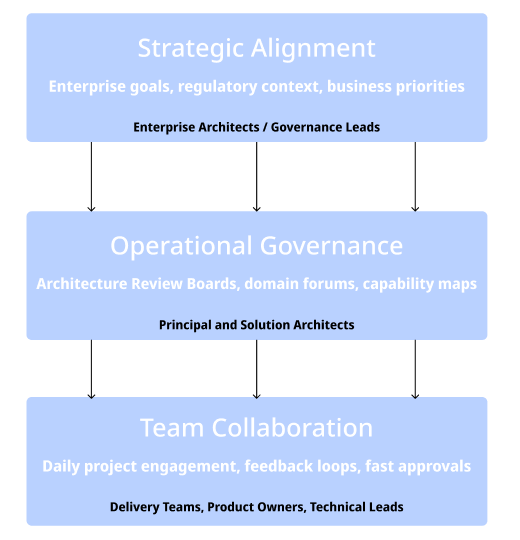
“Architecture Governance.” For many, the term triggers eye rolls and not without reason. It’s often associated with long meetings, slow approvals, and documentation that adds more confusion than clarity. Instead of enabling progress, governance becomes something teams try to avoid or work around.
But governance doesn’t have to be a bottleneck. In complex, fast-moving environments especially those that are highly regulated it can be the very thing that accelerates delivery. The key is to stop treating governance as control and start designing it as collaboration. When it works, it brings alignment, reduces risk, and creates space for innovation.
At IAG GBS, we’ve shifted to a lightweight governance model that’s fast, transparent, and focused on real business value. It’s not perfect but it works. And in this article, I’ll share the principles that helped us make governance a tool for momentum, not a mechanism of delay.
The Governance Trap: What Goes Wrong
Despite the best of intentions, many architecture governance models fall into familiar traps patterns that drain energy, frustrate teams, and ultimately fail to deliver value. These traps don’t emerge from incompetence or malice; they grow from outdated assumptions about control, risk, and organizational behavior. Understanding where governance goes wrong is the first step in making it work.
- Overengineering the Process
One of the most common pitfalls is turning governance into a rigid, overly formalized process. Excessive layers of documentation, approvals, and committee reviews might offer the illusion of control, but they slow decision-making to a crawl. Projects get stuck waiting for signoffs. Architects become process administrators rather than strategic partners. In dynamic business environments, where speed and adaptability are essential, such overengineering renders governance obsolete before decisions even land.
The result? Teams start bypassing governance altogether. Shadow decisions get made without architectural oversight, and the very purpose of governance to align, guide, and de-risk is quietly undermined. Worse, this breeds resentment and disengagement, reinforcing the belief that governance is a bureaucratic hurdle rather than a value-adding function.
- Disconnect from Business Priorities
The second major trap is misalignment. Too often, governance is treated as an IT-led function, separate from real business objectives. Architects are positioned as compliance enforcers focused on checklists, policies, and documentation template rather than as enablers of transformation. When governance doesn’t speak the language of business outcomes, it becomes irrelevant to those who shape them.
Instead of focusing on how architecture decisions support growth, reduce costs, improve resilience, or enable innovation, governance becomes a back-office ritual. This disconnection weakens buy-in, reduces transparency, and turns what should be a strategic tool into a compliance box-ticking exercise. And in the absence of visible business value, governance starts to feel optional a formality to be endured, not embraced.

Lightweight Governance: What It Looks Like
So how do we flip the script? At IAG GBS, we’re shifting toward what I call lightweight, business-aligned governance. Here’s what that means in practice:
- Clarity over Complexity: Fewer templates, more clear thinking. Instead of long documents, we use concise artifacts that answer real questions: What problem are we solving? What capabilities are affected? Who owns the risk?
- Just-in-Time Decisions: Our Architecture Review Boards (ARBs) operate like fast-moving advisory squads, not courtroom judges. We prioritize early engagement and timely feedback sometimes in less than 48 hours.
- Collaborative Design: Architects don’t work in isolation. We co-create with delivery teams, product owners, and business leads. Governance becomes part of the solution, not an obstacle to it.
- Domain Empowerment: We give ownership to domain-specific architects who understand both the business and technical context. Central governance provides standards, but domains drive decisions.
Case in Point: Driving Change in Regulated, Global Environments
In large, complex organizations operating across multiple countries often within regulated industries like finance, logistics, or healthcare change is inevitable. New compliance requirements, evolving customer expectations, and pressure to modernize legacy systems all demand architectural clarity.
To support this kind of transformation, we couldn’t rely on rigid, centralized control. Instead, we established domain architecture forums that support quick validation of decisions, and an Architecture Review Board (ARB) model focused on alignment, not restriction. We’ve also embedded feedback loops to continuously improve the governance model based on real project outcomes.
The result: greater adoption, better traceability, and solutions that land safely for both IT and business stakeholders.
Four Rules to Govern Without Bureaucracy
Based on our experience building and evolving architecture governance across domains and functions, here are four foundational principles that make governance truly effective:
- Don’t Make People Guess
Governance should provide clarity, not confusion. That means well-defined expectations, roles, and processes that are easy to follow even for non-architects.
- Replace ambiguous guidelines with structured checklists and decision trees.
- Use visual models and capability maps to show what’s required and why.
- Ensure contributors understand what “good” looks like from solution design to compliance documentation.
When people aren’t guessing, they spend less time navigating bureaucracy and more time delivering outcomes.
- Make Governance Visible
Governance should never be a black box. Stakeholders need to understand how decisions are made, who is responsible, and how risks are managed.
- Share architecture decisions in open forums or collaborative platforms (e.g., Confluence, Teams, or internal wikis).
- Publish architecture review outcomes, including rationale and trade-offs.
- Use dashboards to visualize governance health such as number of reviews completed, patterns reused, or risks mitigated.
This level of transparency helps demystify governance and builds organizational trust.
- Focus on Business Value
Every architecture decision must trace back to a business capability, objective, or risk. Otherwise, governance becomes an internal IT ritual disconnected from strategy.
- Align architecture reviews with strategic initiatives (e.g., cost reduction, customer experience, regulatory compliance).
- Evaluate proposals not just for technical soundness, but for their impact on the business roadmap.
- Incorporate business stakeholders in governance discussions their input brings focus and accountability.
Governance that fails to connect with value often ends up ignored. But when it’s clearly tied to business outcomes, it earns credibility and engagement.
- Evolve Constantly
Governance is not a set-and-forget framework, it’s a living system that must adapt with the organization.
- Conduct periodic retrospectives with architects and delivery teams to identify friction points.
- Refresh templates, processes, and review criteria based on feedback and lessons learned.
- Keep pace with emerging trends such as AI co-pilots, agile delivery models, and platform architecture by evolving your governance approach accordingly.
A static governance model becomes obsolete fast. An adaptive one becomes a competitive advantage.
When governance is viewed as a burden, it becomes one. But when it’s reimagined as a strategic enabler, it transforms how organizations operate. Governance is not about adding layers of control, it’s about creating a shared language for making better, faster, and safer decisions. When architects, business leaders, and delivery teams align around this purpose, governance becomes an asset that drives momentum, not resistance.
The most effective governance models aren’t the most complex, they’re the most human. They’re built on clarity, trust, and collaboration. They evolve continuously, adapt to change, and reflect the realities of modern delivery. They make room for innovation without compromising on responsibility. And most importantly, they earn respect by helping people do their jobs better, not by telling them how to do them.
So, the next time someone claims governance slows things down, challenge that mindset. Ask: what if governance wasn’t a gate, but a guide? Because in the right hands with the right mindset governance doesn’t delay transformation. It accelerates it. And it becomes one of the most powerful tools we must connect architecture to the business outcomes that truly matter.
